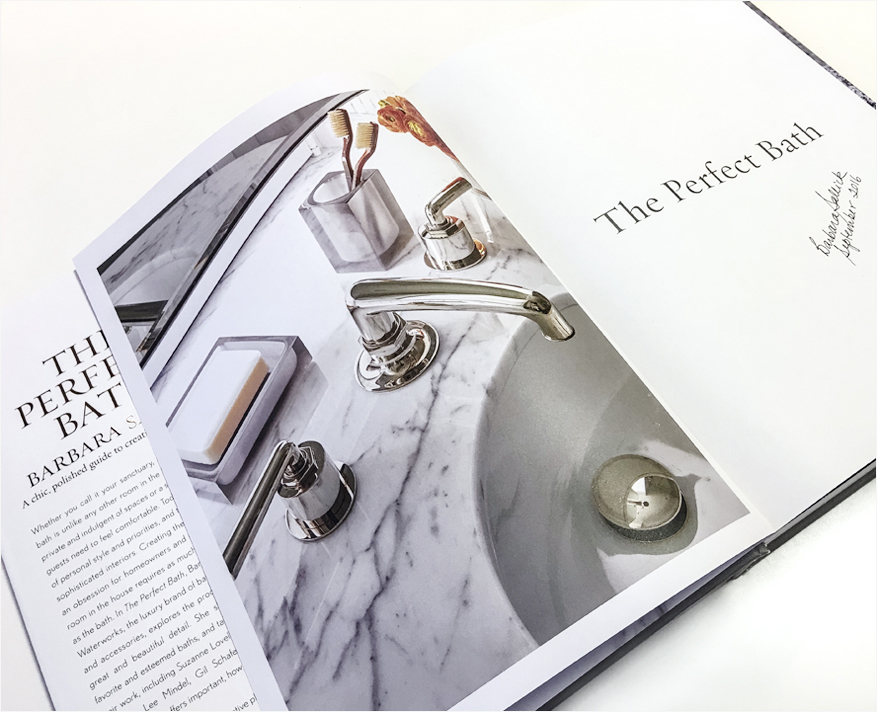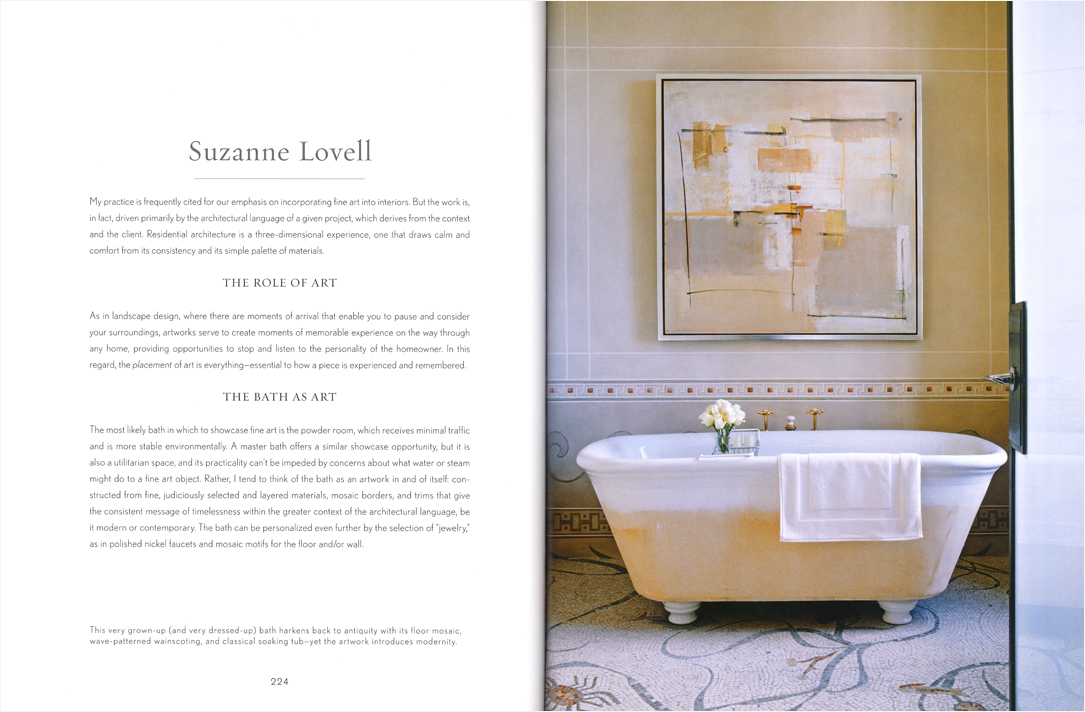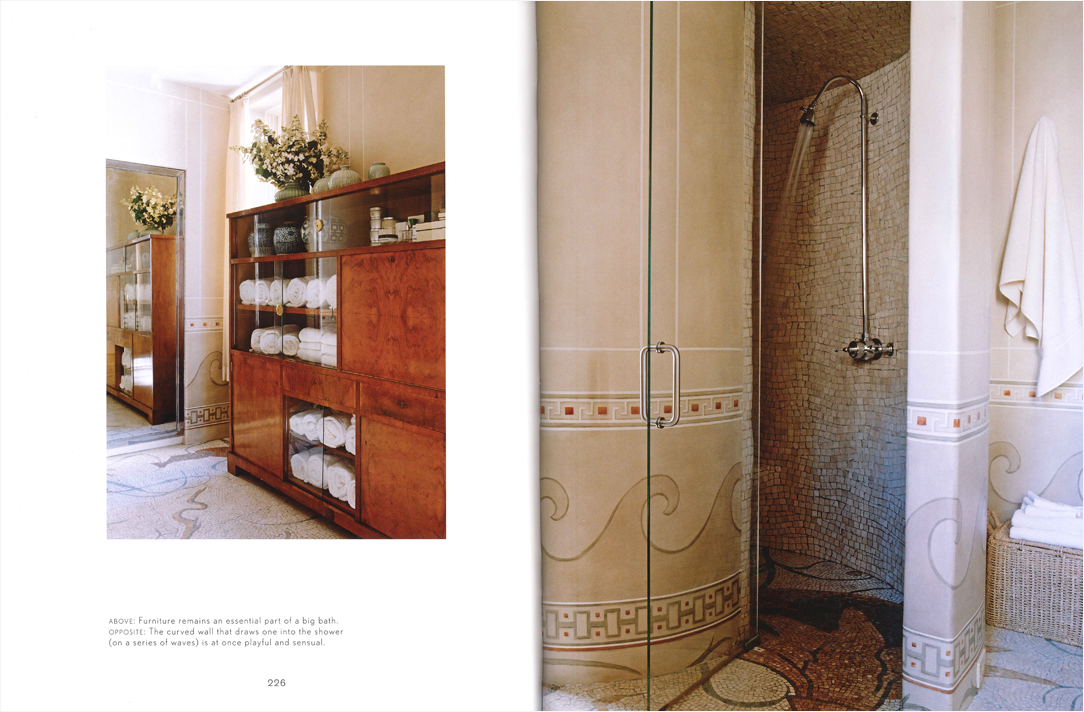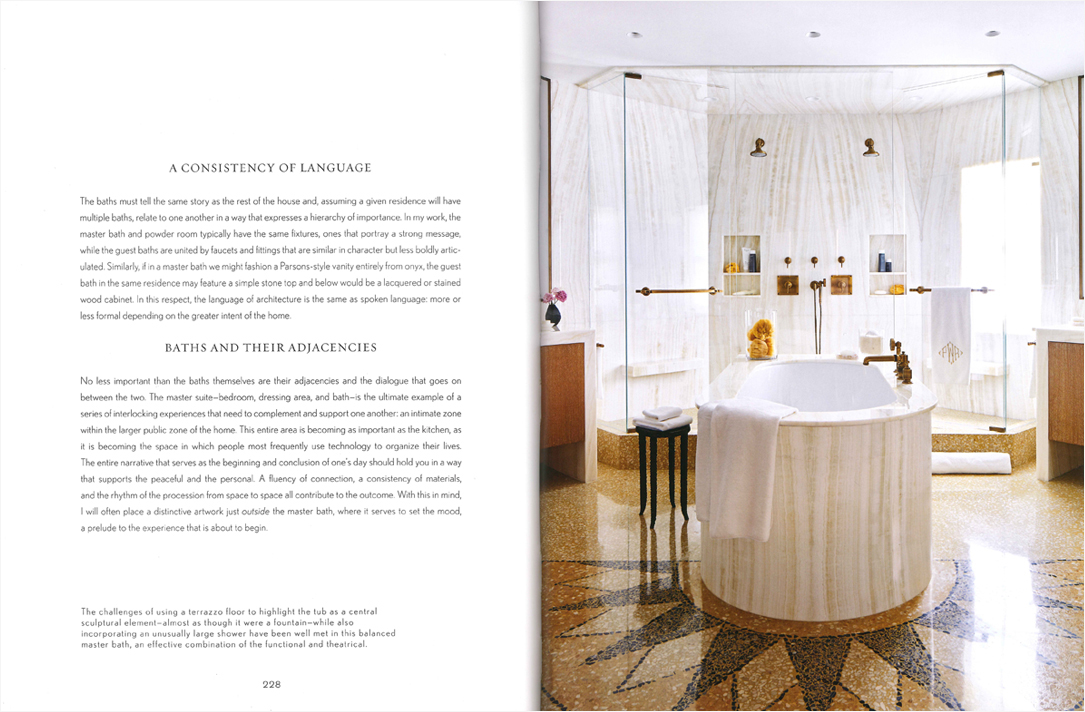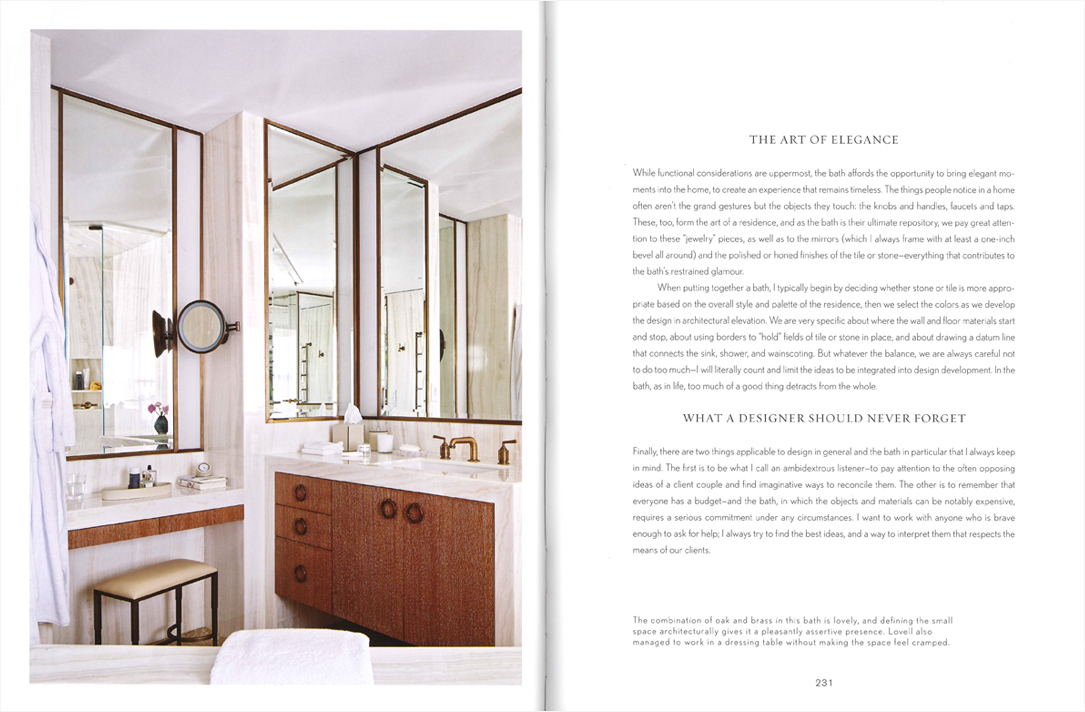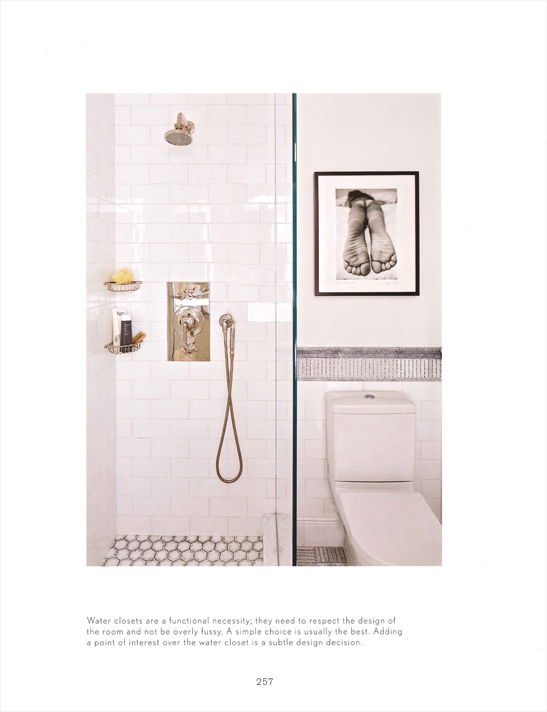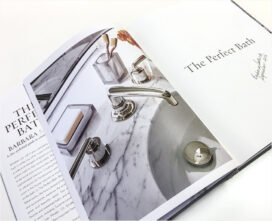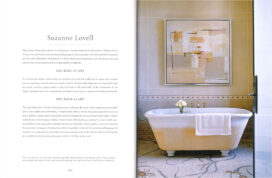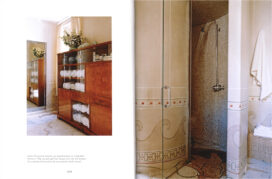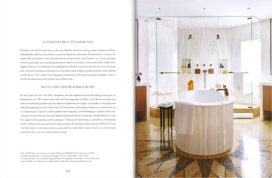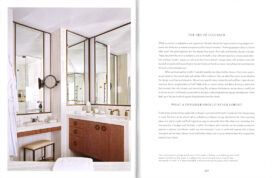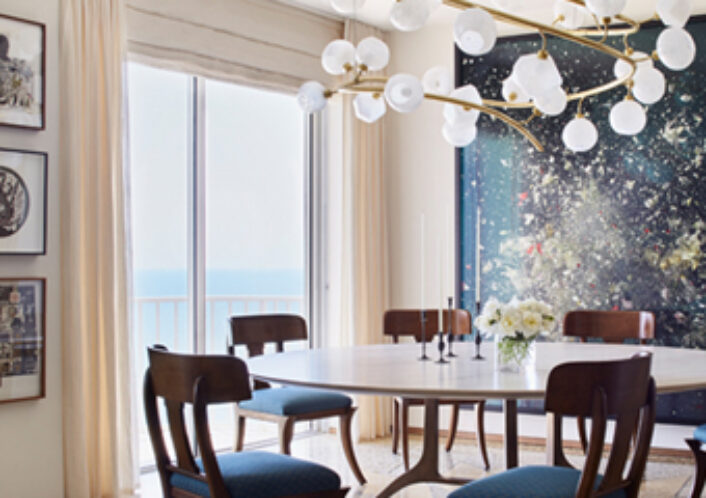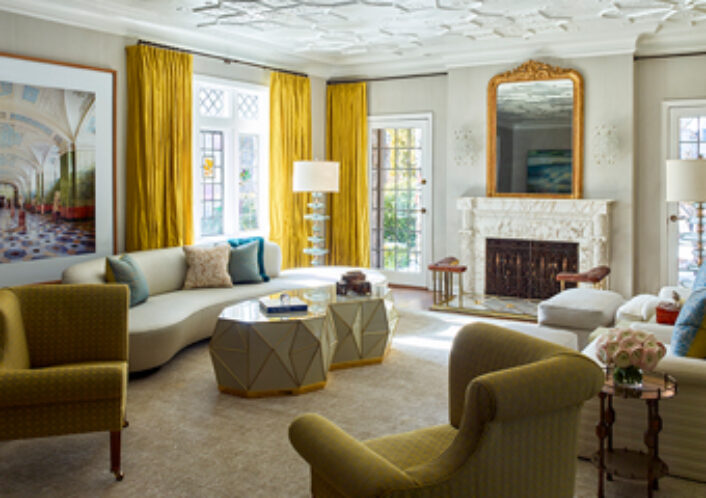The Perfect Bath by Barbara Sallick September 2016
A chic, polished guide to creating your dream bath.
From Dust Jacket:
Whether you call it your sanctuary, retreat, oasis, or spa, the bath is unlike any other room in the house. It can be the most private and indulgent of spaces or a simple, public one in which guests need to feel comfortable. Today’s bath is an expression of personal style and priorities, and the luxurious focal point of sophisticated interiors. Creating the perfect bath has become an obsession for homeowners and designers. Yet perhaps no room in the house requires as much forethought and planning as the bath. In The Perfect Bath, Barbara Sallick, co-ronder of Waterworks, the luxury brand of bath fittings, fixtures, furniture and accessories, explores the process of desinging a bath in great and beautiful detail. She shares exquisite images of favorite and esteemed baths, and talks with top designers about their work, including Suzanne Lovell, Pamela Shamshiri, Thomas O’Brien, Lee Mindel, Gil Schafer, Tim Clarke, and Steven Gambrel, and offers important, how-to advice for homeowners. Combining evocative, informative photography with authoritative, engaging how-to advice for homeowners, The Perfect Bath will be an essential, lasting resource.
SUZANNE LOVELL
My practice is frequently cited for our emphasis on incorporating fine art into interiors. But the work is, in fact, driven primarily by the architectural language of a given project, which derives from the context and the client. Residential architecture is a three-dimensional experience, one that draws calm and comfort from its consistency and its simple palette of materials.
THE ROLE OF ART
As in landscape design, where there are moments of arrival that enable you to pause and consider your surroundings, artworks serve to create moments of memorable experience on the way through any home, providing opportunities to stop and listen to the personality of the homeowner. In this regard, the placement of art is everything-essential to how a pieceis experience and remembered.
THE BATH AS ART
The most likely bath in which to showcase fine art is the powder room, which receives minimal traffic and is more stable environmentally. A master bath offers a similar showcase opportunity, but it is also a utilitarian space, and its practicality can’t be impeded by concerns about what water or steam might do to a fine art object. Rather, I tend to think of the bath as an artwork in and of itself: constructed from fine, judiciously selected and layered materials, mosaic borders, and trims that give the consistent message of timelessness within the greater context of the architectural language, be it modern or contemporary. The bath can be personalized even further by the selection of “jewelry”, as in polished nickel faucets and mosaic motifs for the floor and/or wall.
A CONSISTENCY OF LANGUAGE
The baths must tell the same story as the rest of the house and, assuming a given residence will have multiple baths, relate to one anothre in a way that expresses a hierarchy of importance. In my work, the master bath and powder room typically have the same fixtures, ones that portray a strong message, while the guest baths are united by faucets and fittings that are similar in character but less boldly articulated. Similarly, if in a master bath we might fashion a Parsons-style vanity entirely from onyx, the guest bath in the same residence may feature a simple stone top and below would be a lacquered or stained wood cabinet. In this respect, the language of architecture is the same as spoken language: more or less formal depending on the greater intent of the home.
BATHS AND THEIR ADJACENCIES
No less important than the baths themselves are their adjacencies and the dialogue that goes on between the two. The master suite – bedroom, dressing area, and bath – is the ultimate example of a series of interlocking experiences that need to complement and support one another: an intimate zone within the larger public zone of the home. This entire area is becoming as important as the kitchen, as it is becoming the space in which people most frequently use technology to organize their lives. The entire narrative that serves as the beginning and conclusion of one’s day should hold you in a way that supports thte peaceful and the personal. A fluency of connection, a consistency of materials, and the rhythm of the procession from space to space all contribute to the outcome. This this in mind, I will often place a distinctive artwork just outside the master bath, where it serves to set the mood, a prelude to the experience that is about to begin.
THE ART OF ELEGANCE
While functional considerations are uppermost, the bath affords the opportunity to bring elegant moments into the home, to create an experience that remains timeless. The things people notice in a home often aren’t the grand gestures but the objects they touch: the knobs and handles, faucets and taps. These, too, form the art of a residence, and as the bath is their ultimate repository, we pay great attention to these “jewelry” pieces, as well as to the mirrors (which I always frame with at least a one-inch bevel all around) and the polished or honed finishes of the tile or stone – everything that contributes to the bath’s restrained glamour.
When putting together a bath, I typically begin by deciding whether stone or tile is more appropriate based on the overall style and palette of the residence, then we select the colors as we develop the design in architectural elevation. We are very specific about where the wall and floor materials start and stop, about using borders to “hold” fields of tile or stone in place, and about drawing a datum line that connects the sink, shower, and wainscoting. But whatever the balance, we are always careful not to do too much – I will literally count and limit the ideas to be integrated into design development. In the bath, as in life, too much of a good thing detracts from the whole.
WHAT A DESIGNER SHOULD NEVER FORGET
Finally, there are two things applicable to design in general and the bath in particular that I always keep in mind. The first is to be what I call an ambidextrous listener – to pay attention to the often opposing ideas of a client couple and find imaginative ways to reconcile them. The other is to remember that everyone has a budget – and the bath, in which the objects and materials can be notably expensive, requires a serious commitment under any circumstances. I want to work with anyone who is brave enough to ask for help; I always try to find the best ideas, and a way to interpret them that respects the means of our clients.
